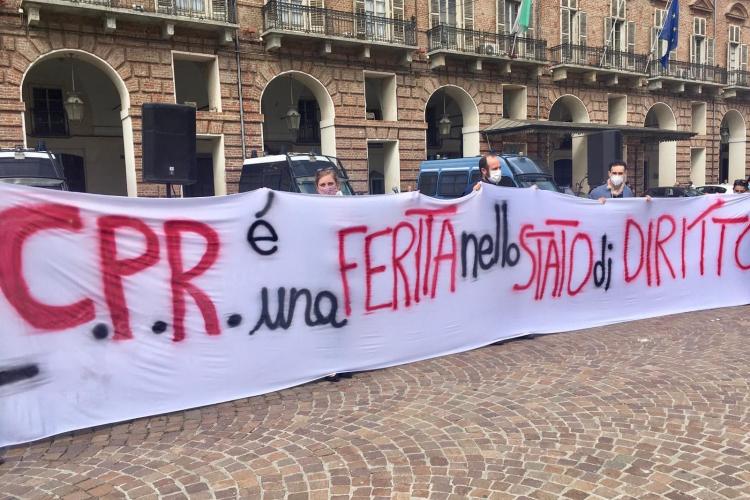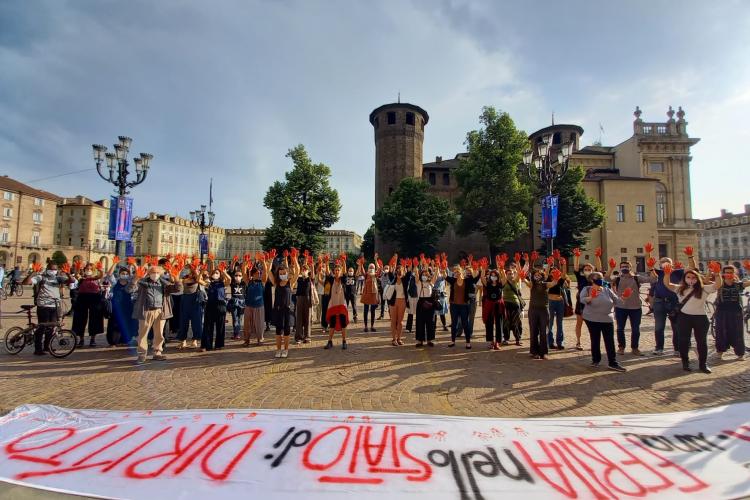Post by Francesca Esposito and Giulia Fabini. Francesca is a Newton International Fellow at the Centre for Criminology at the University of Oxford and an Associate Director at Border Criminologies. Her research focuses on immigration detention in Italy, Portugal and the UK, and, in particular, on the intersection of gendered, sexualised and racialised constructions in everyday life in detention. Giulia is a research fellow at the Department of Legal sciences at the University of Bologna and an adjunct professor in Criminology of the borders at the Department of Political and social sciences. She is a critical criminologist especially interested on border policing, immigration detention, and deportation mechanisms in Italy and the Southern Europe. This is the first post of Border Criminologies themed series on 'Detention And Migrant Confinement in Italy at Times of Covid-19' organised by Francesca Esposito and Giulia Fabini.
Italy was the first country in Europe hit hardest by the Covid-19 outbreak in February 2020, originating a pandemic - or better syndemic - which we are still fighting against. Through the posts of this blog series, which gather together some of the contributions presented at the roundtable “La detenzione amministrativa in Italia alla prova del Covid-19” held online on December 14th 2020, we aim to analyse the way in which immigration detention has been managed during the Covid19 syndemic in Italy, in order to question the possible functions and rationales behind the decision to confine people for immigration-related reasons in such critical times. We also look at border control practices more generally, and how these have been shaped by the hygienic-sanitary logic of social control so prominent in this period.
Covid19 has resulted in countries around the world partially closing their borders, which has largely impeded deportation enforcement; however, the Italian police and migration authorities have continued to detain people. Furthermore, new unofficial forms of detention have started to proliferate, often being justified in the name of a paradoxical “confine to protect” (both migrants and citizens) imperative (see Martina Tazzioli on this). These new hygienic-sanitary borders and bordering practices have enacted forms of racialised containment predicated upon health and safety, ultimately reiterating discriminatory access to rights and mobility and strengthening the hierarchies between citizens and non-citizens.
However, as the virus becomes socially visible through the policies that are put in place to counter it, like a perspective lens, it may uncover the true nature of social control mechanisms. In this light, the syndemic provides us with an exceptional and unique viewpoint from which to observe border control and detention and try to unpack the rationales behind their operation, raising certain questions: if borders were closed and it was impossible to execute deportations, why were people still detained? How can we explain the fact that immigration centres continued to operate, albeit with reduced capacity, throughout this period, and even during the first national lockdown in March-May 2020? Who were the people inside Italian immigration detention centres, and why were they detained? Did they enter immigration detention during the syndemic, or did they remain trapped in the immigration detention system, not deported nor released? What new forms of migrant containment have been taking place in this period and will these be maintained in the future?
This blog series attempt to address some of these questions. As it appears from the contributions, the reality of immigration detention contradicts the apparent function of immigration centres as sites needed for “removals” (i.e., deportations) only. Today, same as before, the police exercise great discretion in selecting those who are affected by this measure, and their power is made even greater by the weak judicial control usually carried out by the Justices of the Peace, as explained by Maurizio Veglio in his post. The rights of people held in detention are constantly violated, for the arbitrariness of the decisions to detain them, but also as a consequence of the poor living conditions that people experience inside the centres, which ultimately violate their fundamental rights (such as the right to health and human dignity). Tragically illustrative in this regard is the recent death of Musa Balde in Turin’s detention centre, critically discussed by Gennaro Santoro in his blog post.
The Covid19 syndemic has exacerbated such pre-existing problems and violations, as described by Mai più Lager no ai CPR in their analysis of Milan’s immigration detention centre (CPR). Yet, migrant detention does not occur only in CPRs. Immigration detention in Italy underwent profound transformations during the so-called “refugees’ crisis” and in its aftermaths. The high number of asylum-seeking people arriving by sea and by land, especially in 2014-2018, in fact, hampered the importance of control at the external borders and led to the decision to strengthen migrant confinement in hotspots. During the syndemic, though, precautionary medical isolation for all persons rescued outside the Italian SAR zone by ships with a non-Italian flag has been held not in the Hotspots, but on “quarantine ships”. Later, in fall 2020, the “quarantine ships” have been used also for precautionary isolation of people already present in the Italian reception system. This is explained in the posts by Laura Lo Verde and Carlo Caprioglio, Lucia Gennari and Francesco Ferri.

New forms of containment and border control, or a renewed use of already well-known forms, originated in the Covid19 syndemic, shedding light also on the racialised nature of these measures.
One of the biggest obstacles that researchers and civil society encounter in denouncing the situation in CPRs, hotspots, quarantine ships, and other places of deprivation of liberty pre-existing or established in this period, is the lack of transparency, the impossibility to access the field and to collect information about what is going on inside. Research and critique need coherent, complete and solid data. This blog series is a contribution to a collective reflection, and it is an invitation to the civil society and the academia to gather and continue a dialogue on immigration detention and migrant confinement in Italy, to read the current scenario and the possible future configurations of a reality that we know is hardly readable, multifaceted and change over time. Above all, however, it is a call for joining efforts toward an abolitionist project, aimed not only at immigration detention but also at the broader border regime in which it is embedded, because this system has already taken a high toll – as reminded to us by the tragic death of Musa Blade – and it is time to take a stand.

Any comments about this post? Get in touch with us! Send us an email, or post a comment here or on Facebook. You can also tweet us.
__________
How to cite this blog post (Harvard style)
Esposito, F. and Fabini, G. (2021). Detention And Migrant Containment in Italy at Times of Covid-19. Available at: https://www.law.ox.ac.uk/research-subject-groups/centre-criminology/centreborder-criminologies/blog/2021/06/detention-and [date]
Share:








